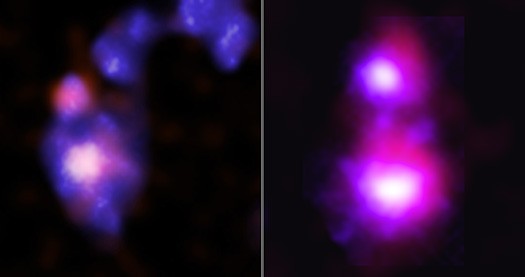New research utilizing NASA's Chandra X-ray Observatory monitored two pairs of supermassive black holes in dwarf galaxies on collision trajectories, as detailed in a recent news release.
This is the first evidence of such an approaching collision, providing scientists with crucial knowledge regarding the early Universe's proliferation of black holes.

"Mirabilis" black hole collision on the left, and black holes “Elstir” and “Vinteuil" on the right.
How Chandra X-ray Observations Helped in This Discovery
Dwarf galaxies, by definition, have stars with a total mass of fewer than 3 billion Suns or around 20 times less than the Milky Way. Scientists have long hypothesized that dwarf galaxies combine, particularly in the early Universe, to form the bigger galaxies observable today.
Unfortunately, current technology cannot witness the initial generation of dwarf galaxy mergers because they are so weak at such enormous distances. Another strategy, hunting for dwarf galaxy mergers closer to home, had failed thus far.
But scientists of the new study were able to overcome these challenges. According to NASA, scientists conducted a systematic evaluation of deep Chandra X-ray observations and compared them to infrared data from NASA's Wide Infrared Survey Explorer (WISE) and optical data from the Canada-France-Hawaii Telescope (CFHT).
Chandra was notably useful for this investigation because the material surrounding black holes may be heated to millions of degrees, resulting in massive volumes of X-rays. The researchers looked for pairs of strong X-ray sources in colliding dwarf galaxies as evidence of two black holes and found two.
READ ALSO: Two Supermassive Black Holes Predicted to Collide Within Three Years: Here's What to Expect
Colliding Pairs of Black Holes in Dwarf Galaxies
The first pair of black holes were in the galaxy cluster Abell 133 located 760 million light-years away, NASA reported. The pair appears to be in the late stages of a merger and sports a long tail, perhaps due to the tidal effects of their collision. Authors dubbed it the "Mirabilis" from an endangered species of hummingbird known for their exceptional long tails.
Scientists only chose one name since the merger between the two black holes is almost complete. Chandra's observations reveal the X-rays from the material surrounding the black holes from each dwarf galaxy.
Meanwhile, the second pair was found from another dwarf galaxy from 3.2 billion light-years away called Abell 1758S. Researchers called named them separately as "Elstir" and "Vinteuil" from fictional characters in Marcel Proust's book "In Search of Lost Time."
In the picture, the pair on the right are Vinteuil and Elstir, in which the former is the top galaxy, and the latter is the bottom galaxy. Both feature Chandra sources, which are X-rays from material surrounding black holes in each galaxy.
Unlike Mirabilis, researchers believe these two are in the early stages of merging, causing a bridge of stars and gas to form from the gravitational attraction of the two converging galaxies.
First Time Observations on Colliding Galaxies Offer Insights into Early Universe
University of Alabama physics student Olivia Holmes, a co-author of the study, said in a statement that they could identify the first two pairs of black in colliding dwarf galaxies. She noted that these systems could offer insights into the early universe, their first black holes, and the stars they formed after colliding.
Previous models of the "cosmic dawn" revealed that billowing clouds of frigid gas may have gathered into huge stars doomed to collapse quickly, forming black holes, Live Science reported. As these black holes increased in size, the surrounding gas trains condensed into stars, eventually producing dwarf galaxies.
Studying dwarf galaxies could reveal vital clues into how the supermassive black hole in the Milky Way grew as massive as it is today from being a tiny black hole seedling.
RELATED ARTICLE: Black Holes Crashing Into Each Other Generate Gravitational Waves, Distorting Space-Time
Check out more news and information on Black Holes in Science Times.














